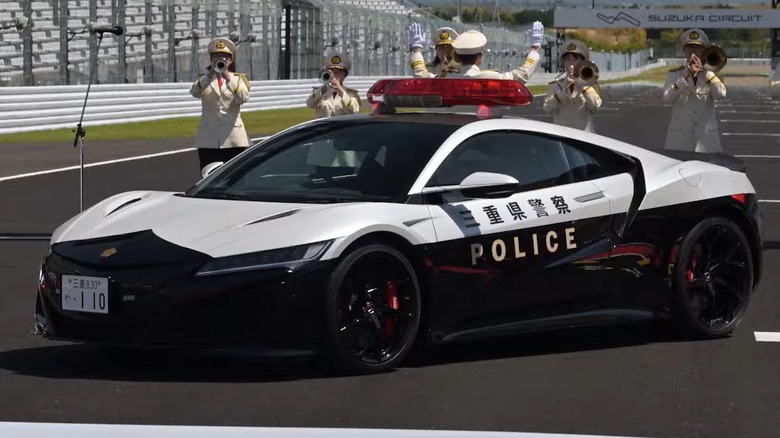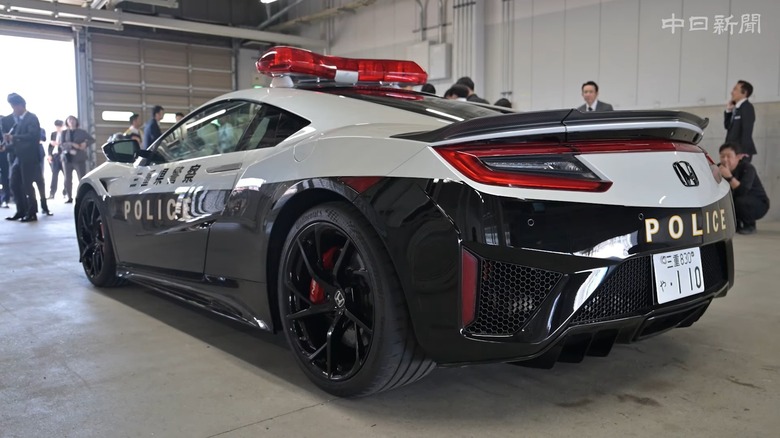This Honda Supercar Now Serves In The Japanese Police Force, So Don't Try To Outrun It
Mie Prefecture is home to Suzuka Circuit, an FIA Grade 1 racing circuit that is among the most popular motorsports venues in Japan. It sees regular use in several racing series, such as Super GT and Super Taikyu. In April 2025, it hosted a different sort of event: the unveiling ceremony for a rather unique police interceptor, adorned in a Mie Prefectural Police livery. Sporting the chrysanthemum crest, which legally distinguishes it as a police vehicle, is a modern Honda NSX — Honda's most powerful factory-production car. Not exactly something you'd want to see in your rear-view mirror if you happen to be speeding down the expressway.
This NSX is among the most powerful police vehicles in the world, and certainly more potent than the usual Toyota Crown seen patrolling city streets. Reportedly, the NSX boasts a grand total of 573 horsepower, though who knows if there's been any work done to it before or since entering service. The car came courtesy of Toshiya Kobayashi, a real estate mogul and car enthusiast residing in Kusatsu City of Shiga Prefecture, who donated the vehicle worth an estimated 25 million yen (around $175,000 USD) including modifications.
There's no word from the Mie Prefectural Police as to whether or not the NSX has since been modified, or had engine modifications prior to their acquisition. But with that much power sent to all four wheels, it's certainly more than adequate if it ever sees patrol duty. Let's talk about the car itself, as well as the role of these exotic police vehicles on Japanese streets.
The infamous Japanese highway police interceptors, and why they're necessary
Japan boasts one of the world's premiere automotive cultures, born from a rich and diverse history of building and tuning fast cars. One of its highlights for the past several decades has been its vibrant street racing scene and the cars it features, like Smokey Nagata's brand "Top Secret." Japan hosts several distinct racing disciplines, ranging from running through city expressways to drifting down mountain passes.
Both sanctioned and illegal races occurred with enough regularity that police have employed specialized pursuit vehicles since the 1970s, peaking in the 1990s with gangs like Tokyo's infamous Mid-Night Club and Osaka's many Kanjozoku groups. These organizations employed some truly outstanding machines, with some capable of keeping pace with today's modern supercars. Of course, technology has advanced considerably over the past several decades, and today's expressway police need suitable vehicles to keep up with some of the monsters running through the night.
It's a common myth perpetuated by the media that Japan simply doesn't chase anyone going over a certain speed. In reality, they certainly will, and employ a variety of cars to do the job. Some of these include vehicles like a Lexus LC 500, several Nissan models like the 350Z and GT-R series, the first-generation Honda NSX, and Toyota Soarer. Many feature bespoke modifications that allow police to chase even the hardiest of street racers, a necessary measure given their former prominence on Japan's expressways. Today, most modern Japanese police forces equip patrol units with cars like the ubiquitous Toyota Crown, which in the 3.5L Athlete trim, is a capable performance car by itself.
The theoretical uses for the Honda NSX patrol car
These days, highway street racing is far less commonplace due to a variety of factors — notably due to declining interest in the hobby, as well as heightened police presence. Cars like the now-discontinued (twice) Honda NSX don't merely serve as symbols of pride among their ranks, but they are legitimate interceptors bearing a chrysanthemum badge like any other Japanese cop car. Granted, their role is far more unique than the average cruiser, but they do serve the public.
For instance, Italian police units utilize a specially-modified Lamborghini Huracán to transport urgently-needed medical supplies, being featured in the news for delivering kidneys to two people. Of course, this all comes in addition to the cars participating in normal patrol duties, something which the Japanese equivalents have always performed. For instance, an original Nissan Fairlady ZG ended its career with over 230,000 miles clocked. Japanese police continue operating exotic cars on patrol to this day, so a Honda NSX with red lights patrolling the streets is certainly on the table.
As for whether the Mie Prefectural Police will use the Honda NSX in this manner is anybody's guess at the moment. It's certainly not unheard of for specialized police units to patrol particularly notorious stretches of highway in both marked and unmarked vehicles. Though, obviously, most police units aren't forthcoming about what vehicles patrol where or how often they're used. Some police units simply use vehicles like these for publicity and ceremonial duties, including Japanese examples. Theoretically, the NSX could see service for any number of tasks, from catching street racers to first-response.


